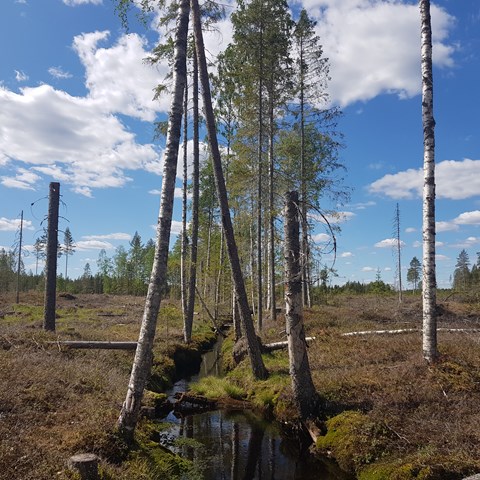Contact
Department of Forest Ecology and Management, Department of Forest Ecology and Management, joint staff

To diminish the negative impacts of tree felling, a protected corridor in the riparian zone is recommended in many countries. But the guidelines are too vague and unclear to achieve the desired outcome, shows a review by SLU-researchers among others.
Our streams are vital sources of both life and water, and their riparian zones are habitats for various species.
However, forestry activities nearby risk negatively impacting these ecosystems through increased temperatures, sediment movement, and an increase in soluble substances in the water. Therefore, forestry practices in many countries follow regulations and recommendations of leaving strip of trees along streams to protect them from this negative influence. However, these practices do not always yield the desired results.
Researchers from the Swedish University of Agricultural Sciences, the University of Oulu in Finland, and the University of British Columbia in Canada now shed light on the existing recommendations in these three countries in a joint article.
They found that the current goals and guidelines for riparian zone protection in these countries are vaguely formulated, making it challenging to implement and monitor them. The goals tend to be general and imprecise, such as "protect" or "minimize impact," making it difficult to measure the effectiveness of protective measures.
As a result, a majority of streams receive inadequate protection, even if they, in many cases, follow the recommendations, according to the researchers' earlier study involving 286 smaller streams.
For example, in Sweden, there is a recommendation to leave deadwood in and around streams of water. The clear intention is to increase the ecological complexity and provide habitats for more species. However, since there are no specifications on the amount of deadwood to be left, it is up to the practicioners to make a subjective judgment that does not always lead to the desired effect, as noted by the researchers.
The researchers argue that recommendations should change from the current vaguely formulated goals like "protect and prevent" to a defined set of values for ecological parameters that buffer zones are expected to provide. These could include specific levels of shading, microclimate goals, specific amounts of deadwood, or the composition of tree species in the shorelines.
The researchers also emphasize the need for an open dialogue among authorities, landowners, forestry, and researchers to formulate these goals and protect biologically valuable environments effectively.
Read the researchers' blog post in full: https://appliedecologistsblog.com/2023/12/14/enhancing-riparian-protection-a-call-for-clear-objectives-and-measurable-targets/
Read the entire scientific article here: https://besjournals.onlinelibrary.wiley.com/doi/10.1111/1365-2664.14549